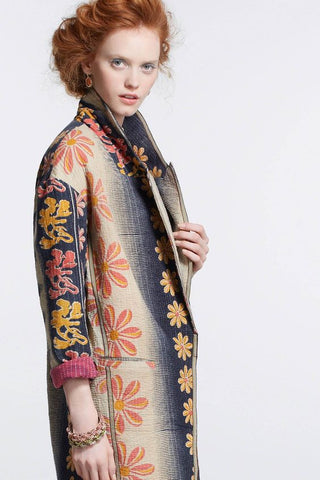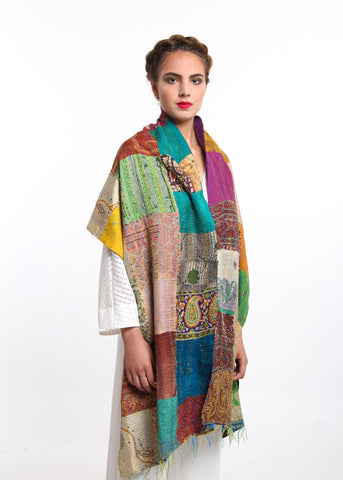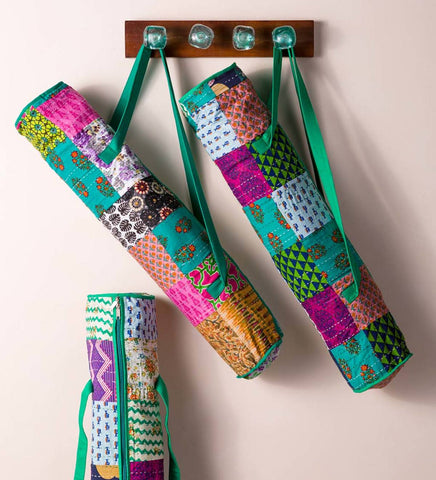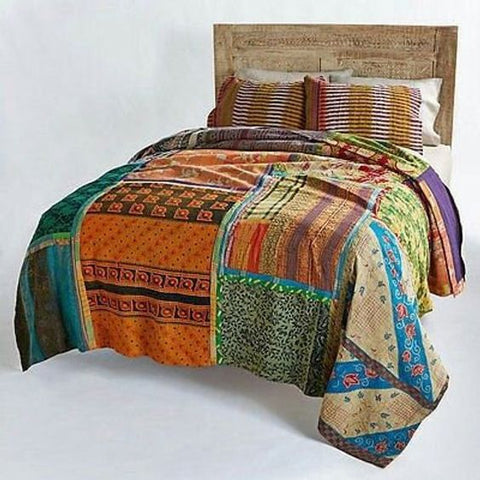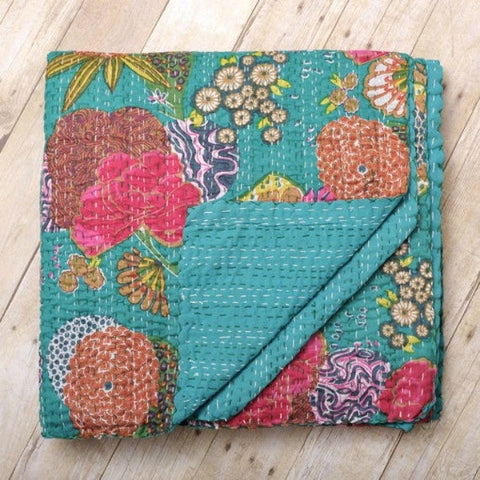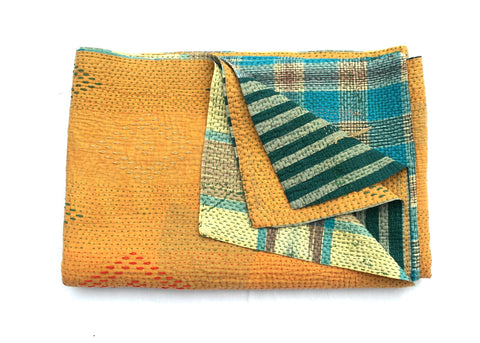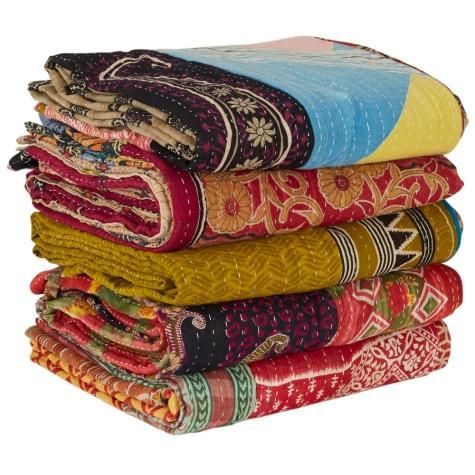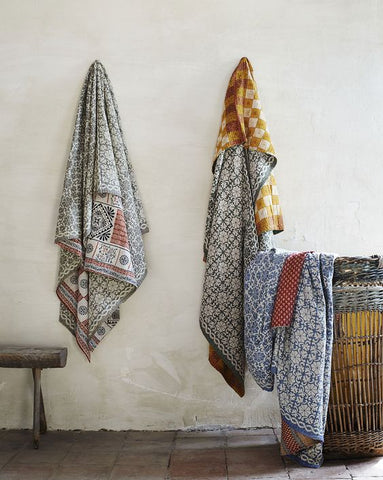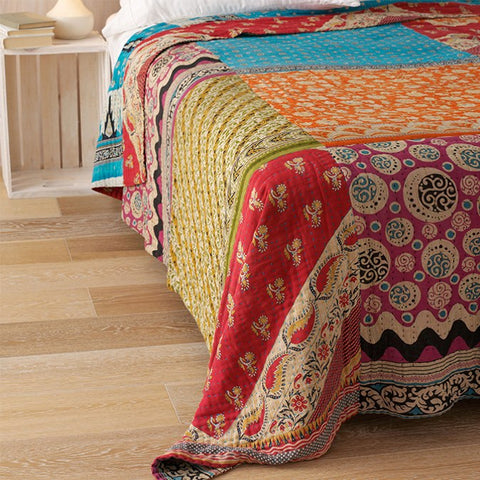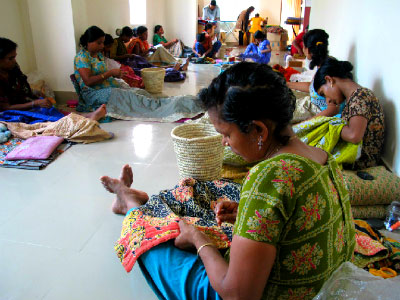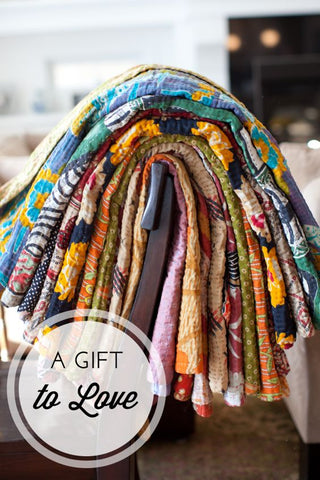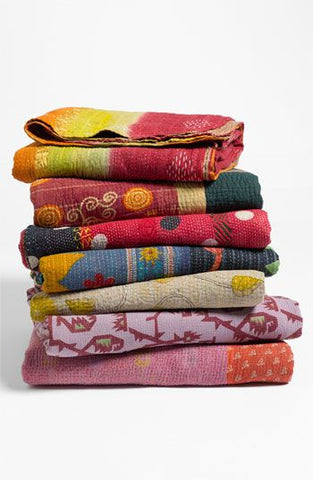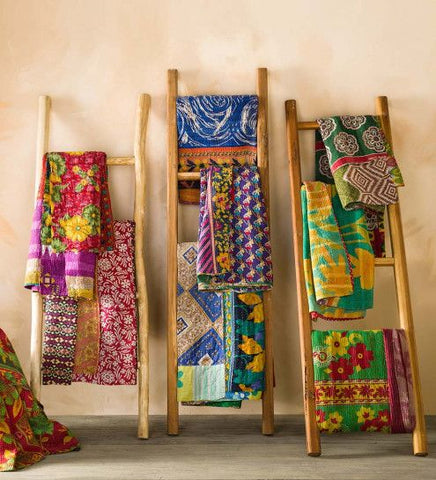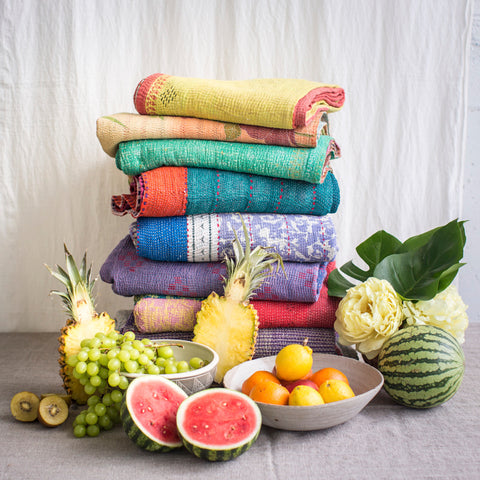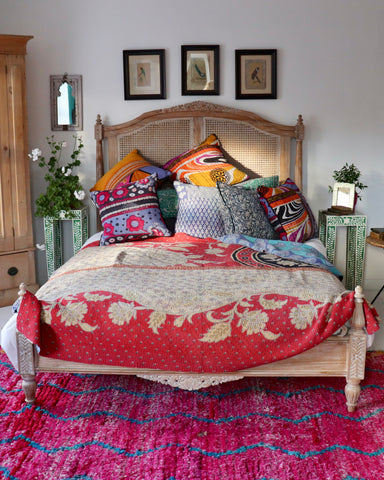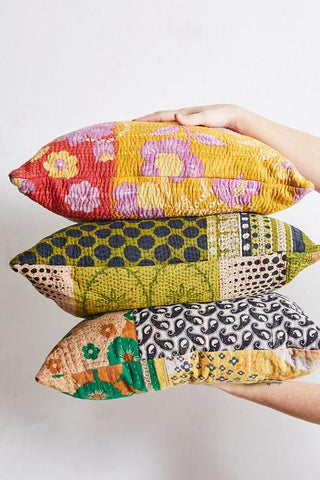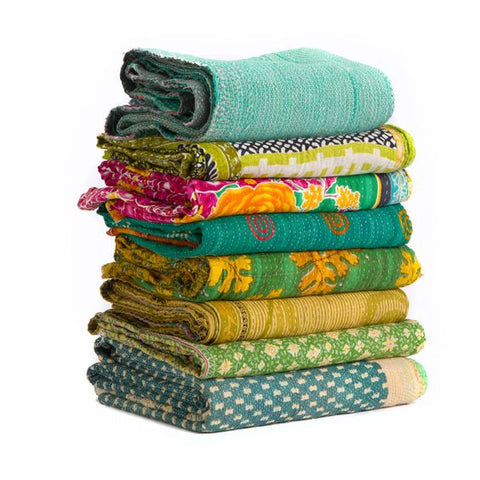Exquisite Kantha Quilts: Handcrafted Elegance for Your Home | Jaipur Handloom / indian handmade kantha quilt
How do I care for a Kantha Quilt - AfterCare
Hand Washing Your Kantha Quilt
The kantha quilt was traditionally washed by hand in India and Bangladesh. This is still the best option for cleaning your blanket to reduce the risk of pulls. For best results, fill a bathtub with cold to lukewarm water (below 30°C/86°F) and use a mild detergent.
Read more →
Hand Washing Your Kantha Quilt
The kantha quilt was traditionally washed by hand in India and Bangladesh. This is still the best option for cleaning your blanket to reduce the risk of pulls. For best results, fill a bathtub with cold to lukewarm water (below 30°C/86°F) and use a mild detergent.
Hundreds of Fresh New Kantha quilts are now available on Jaipur Handloom
Each kantha has wildly varied colours and patterns, but you'll notice that they always go well together. Who wouldn't love these appealing and gleaming kantha blankets? They bring new colours and a sense of history into the home.
These kantha quilts contain contrasting patterns on both sides, which is one of its many unique features. Typically, one side has a bold, heroic print while the other is more delicate. So, if you prefer to switch up your decor frequently, these are practically two blankets in one!
Read more →
Each kantha has wildly varied colours and patterns, but you'll notice that they always go well together. Who wouldn't love these appealing and gleaming kantha blankets? They bring new colours and a sense of history into the home.
These kantha quilts contain contrasting patterns on both sides, which is one of its many unique features. Typically, one side has a bold, heroic print while the other is more delicate. So, if you prefer to switch up your decor frequently, these are practically two blankets in one!
Story Behind Kantha Quilts | Vintage Kantha Quilts and Throws
Kantha is the most prominent form of embroidery often practiced by rural women in east Asia, especially in India and Bangladesh. It is often used to make simple kantha quilts, also known as Nakshi Kantha.
The traditional form of Kantha embroidery are usually handmade or hand-woven with soft saris and dhotis,with a running stitch along the edges. The finished products are known as sujni Kantha or lep Kantha depending on the use of the finished product. The embroidery are sometimes made into scarves, bags, covers for mirror, boxes, pillows and even bed covers.
Vintage Kantha quilts are products of 2-3 layers recycled Indian vintage saris- this could either be in cotton fabric or silk. They are usually covered with running stitches, employing beautiful designs of flowers, birds, animals, shapes as well as designs from everyday activities.
The origin of handmade kantha quilts can be traced to some very resourceful women centuries ago. Poor women in rural area of west Bengal in India needed blankets for their babies, so they sourced for the softest parts of their old cotton saris and handmade them together with an all-over running stitches. This unique stich came to be known as kantha, and this brought about the advent of handmade Kantha quilts. The best aspect of vintage or handmade Kantha quilts is how easy it is to repair patches, especially their loose and uneven threads that adds immense character to the throws. This completely hand-weaven vintage Kantha throws are such a beautiful and refreshing break from the mass produced machine made products.
This beautiful handcraft has gained more international recognition and acceptance as it portrays the beauty of India craftsmanship. However, there are various types of kantha quilts;
1. Lep kantha quilts
The lep Kantha quilt is a much larger type of quilt used mostly during the winter season, in places with more severe winter experience, The lep Kantha quilt is mostly made up of 7 layers. Lotus is usually the central motif with the other designs coming up in small sewn stitches to present a wavy surface. It is also called lahari, lahari is known toean waves. The lep kantha quilts often has geometric patterns or designs. Motif designs of plants and trees can be prominently seen.
2. Sujni Kantha quilts
The prominent sujni kantha quilt is generally four and a half feet wide and six feet long in measurement. It is often used as bedspread for guests to sit or lie on . just like the lep kantha quilts, the sujni kantha quilts equally usually have a lotus motif in the center,border designed with different kinds of plants and flowers. It reflects the rich art of Bengal embroidery. The sujni kantha can be classified into two categories. The anchal bunani where designs resemble the end of a sari, then there is the Dorokha kantha,design also appear in identical form in the back of the kantha quilting making it a reversible kantha quilt.
3. Asian kantha quilting
This is usually used during functions for guest to sit. In Bangladesh it is also also known as khat or bed kantha, khat means bed. In other words it could be referred to as blanket size kantha quit, its motif are related to religious belief.
4. Shawl kantha quilt
This kantha quilt is usually used to wrap the body and has only two layers of fabric and its motif is dotted with flowers and plants in the center and rows of decorative embroidery along the border.
Indian kantha quilts is today being appreciated around the world for its beauty and uniqueness. Shop these adorable Cotton Kantha quilts.
Read more →
Kantha is the most prominent form of embroidery often practiced by rural women in east Asia, especially in India and Bangladesh. It is often used to make simple kantha quilts, also known as Nakshi Kantha.
The traditional form of Kantha embroidery are usually handmade or hand-woven with soft saris and dhotis,with a running stitch along the edges. The finished products are known as sujni Kantha or lep Kantha depending on the use of the finished product. The embroidery are sometimes made into scarves, bags, covers for mirror, boxes, pillows and even bed covers.
Vintage Kantha quilts are products of 2-3 layers recycled Indian vintage saris- this could either be in cotton fabric or silk. They are usually covered with running stitches, employing beautiful designs of flowers, birds, animals, shapes as well as designs from everyday activities.
The origin of handmade kantha quilts can be traced to some very resourceful women centuries ago. Poor women in rural area of west Bengal in India needed blankets for their babies, so they sourced for the softest parts of their old cotton saris and handmade them together with an all-over running stitches. This unique stich came to be known as kantha, and this brought about the advent of handmade Kantha quilts. The best aspect of vintage or handmade Kantha quilts is how easy it is to repair patches, especially their loose and uneven threads that adds immense character to the throws. This completely hand-weaven vintage Kantha throws are such a beautiful and refreshing break from the mass produced machine made products.
This beautiful handcraft has gained more international recognition and acceptance as it portrays the beauty of India craftsmanship. However, there are various types of kantha quilts;
1. Lep kantha quilts
The lep Kantha quilt is a much larger type of quilt used mostly during the winter season, in places with more severe winter experience, The lep Kantha quilt is mostly made up of 7 layers. Lotus is usually the central motif with the other designs coming up in small sewn stitches to present a wavy surface. It is also called lahari, lahari is known toean waves. The lep kantha quilts often has geometric patterns or designs. Motif designs of plants and trees can be prominently seen.
2. Sujni Kantha quilts
The prominent sujni kantha quilt is generally four and a half feet wide and six feet long in measurement. It is often used as bedspread for guests to sit or lie on . just like the lep kantha quilts, the sujni kantha quilts equally usually have a lotus motif in the center,border designed with different kinds of plants and flowers. It reflects the rich art of Bengal embroidery. The sujni kantha can be classified into two categories. The anchal bunani where designs resemble the end of a sari, then there is the Dorokha kantha,design also appear in identical form in the back of the kantha quilting making it a reversible kantha quilt.
3. Asian kantha quilting
This is usually used during functions for guest to sit. In Bangladesh it is also also known as khat or bed kantha, khat means bed. In other words it could be referred to as blanket size kantha quit, its motif are related to religious belief.
4. Shawl kantha quilt
This kantha quilt is usually used to wrap the body and has only two layers of fabric and its motif is dotted with flowers and plants in the center and rows of decorative embroidery along the border.
Indian kantha quilts is today being appreciated around the world for its beauty and uniqueness. Shop these adorable Cotton Kantha quilts.
What is Kantha? | History of Kantha | Untold Story of Vintage Kantha Quilt
With countless blankets that we refer to as “kantha throws”, “kantha quilts“, “indigo kantha”, or “kantha blankets“, you might simply awe, what is kantha? and often wondered to know more about – History of Kantha –
Kantha (simply means : “patched cloth”) refers to both the tradition of producing these unique, colorless quilted blankets (making something useful and alluring out of discarded and unused items), as well as the craft and stitch itself (a small, straight running stitch specially in Bengali embroidery).
WHERE DOES ORIGINAL KANTHA ORIGINATE?
Kantha is a classical type of embroidery native to eastern South Asia, in particular Bangladesh and the neighbouring Indian states of West Bengal and Odisha, along the Bay of Bengal. For this logic, it is treated a craft of the Bengal region (“Bengali”), which is not the same as Bangladeshi (meaning, of the country of Bangladesh).
All of our kantha blankets are hand-stitched in Bengal, India. Formally, it is pronounced KAHN-taa, (nevertheless we will unofficially continue to incorrectly call it “can-tha”).
For as many as 500 centuries, impoverished Bengali women have taken their discarded cloth scraps and sewn them together with a simple running stitch; taking the old and reimposing it into something useful and possessive. Far from trend-setting, or even artfulness, kantha was constructed originally for the most basic and practical aspiration: to keep warm.
Over time, kantha developed as a generational artistry, a craft that could symbolically impart story, desire, and well-wishing for loved ones & gift recipients. Elaborate kantha were made as wedding gifts or gifts for mothers and for generations, with stories, history and wishes weaved in, allowing illiterate women to leave a eternal mark.
Kantha Today :
Today, the rich tradition of kantha has attained popularity in the West; no surprise, given the beauty, intricacy, and “wow” factor of each piece.
As we culturally trend away from disposable consumer goods, and en-route meaningful, well stitched goods with a low environmental buffet, Kantha blankets happily fit the bill.
The cloth is repurposed, which means no new dyes or inks (except for the environmentally happy natural indigo blankets), no by-products of production; the only factory-produced supplies we use are thread and new, undyed, natural cotton (for our modern quilts).
Our kantha blankets — sometimes called sari quilts or homemade quilts— are not made of rugs, nor do they feature deliberately designed stitch patterns. But, they are indeed formed and fashioned from old cloth that has been junked and is ready for new life.
Our “special” silk-blend blankets are made from silk-blend cloth discarded by the producers for flaws, colour variation, out-dated arrangement, or as remnants. All the cloth that makes kantha blankets sold at Jaipur Handloom is sourced mainly in West Bengal.
All of vintage kantha quilts & other goods are made at Jaipur Handloom has following features:
Thickness: Each layer of sari cloth is very thin (imagine a soft muslin for a baby swaddle), so if there are only 2, the blanket will be very light. The standard one is 3 layered. This is the most common thickness in the native regions, but region where cold in heavy there generally 6 layered are used to keep the body warm.
Our kantha quilts are made with 3 layers of sari cloth. We also accept customized orders where we construct quilts based on requirement of customers – pattern ,size and other. The final product is still not bulky, but definitely as “robust” as kantha come. They are light weighted, but provide a good warmth, as well. (Any kantha made with new cloth, like our modern paisley, fruit and floral blanket, have additional thickness & weight) and are accepted worldwide.
Stitching : How heavy do you expect the running stitches to be? A blanket with very tight, close stitching will have a more stark, generous feel than stitching that is farther apart.
Edge Stitching : This is where a more inexpensively produced, lower quality kantha will divulge itself. A well-made kantha should have a straight edge, with a kantha stitch right up to the edge, hinder any erode or interior cloth coming out.
Our kantha are stitched with rigor all around!
Color / Fading : Keep in mind that if a kantha quilt features faded or very pastel colors, it is more likely that the fabric has been more frequently washed, or is old; the fibres may break down more quickly than other fabrics. Consider this as uniqueness and charm as these are rare. Women in Bengal (who are originally wearing these saris) love different color & vibrance, so these are what you will (should) mostly find with authentic kantha blankets.
Cost : Of course, we are all cost-conscious. But, there is a large amount of labour involved in generating even a single kantha throw. Our kantha throws take, on average, 24-48 hours to handcraft and for final finish. Our kantha blankets are all made in a generous, safe, whole-hearted business by vulnerable & at-risk women who can work with dignity and work to earn livelihood.
We have a strong belief from our products and are confident that you won’t find a kantha that is as unique, colourful, versatile, rich in story, or as well-constructed as our hand-stitched kantha quilts.
Contact us to know more about patterns and vibrant colors of kantha quilts and other kantha handmade products
Read more →
With countless blankets that we refer to as “kantha throws”, “kantha quilts“, “indigo kantha”, or “kantha blankets“, you might simply awe, what is kantha? and often wondered to know more about – History of Kantha –
Kantha (simply means : “patched cloth”) refers to both the tradition of producing these unique, colorless quilted blankets (making something useful and alluring out of discarded and unused items), as well as the craft and stitch itself (a small, straight running stitch specially in Bengali embroidery).
WHERE DOES ORIGINAL KANTHA ORIGINATE?
Kantha is a classical type of embroidery native to eastern South Asia, in particular Bangladesh and the neighbouring Indian states of West Bengal and Odisha, along the Bay of Bengal. For this logic, it is treated a craft of the Bengal region (“Bengali”), which is not the same as Bangladeshi (meaning, of the country of Bangladesh).
All of our kantha blankets are hand-stitched in Bengal, India. Formally, it is pronounced KAHN-taa, (nevertheless we will unofficially continue to incorrectly call it “can-tha”).
For as many as 500 centuries, impoverished Bengali women have taken their discarded cloth scraps and sewn them together with a simple running stitch; taking the old and reimposing it into something useful and possessive. Far from trend-setting, or even artfulness, kantha was constructed originally for the most basic and practical aspiration: to keep warm.
Over time, kantha developed as a generational artistry, a craft that could symbolically impart story, desire, and well-wishing for loved ones & gift recipients. Elaborate kantha were made as wedding gifts or gifts for mothers and for generations, with stories, history and wishes weaved in, allowing illiterate women to leave a eternal mark.
Kantha Today :
Today, the rich tradition of kantha has attained popularity in the West; no surprise, given the beauty, intricacy, and “wow” factor of each piece.
As we culturally trend away from disposable consumer goods, and en-route meaningful, well stitched goods with a low environmental buffet, Kantha blankets happily fit the bill.
The cloth is repurposed, which means no new dyes or inks (except for the environmentally happy natural indigo blankets), no by-products of production; the only factory-produced supplies we use are thread and new, undyed, natural cotton (for our modern quilts).
Our kantha blankets — sometimes called sari quilts or homemade quilts— are not made of rugs, nor do they feature deliberately designed stitch patterns. But, they are indeed formed and fashioned from old cloth that has been junked and is ready for new life.
Our “special” silk-blend blankets are made from silk-blend cloth discarded by the producers for flaws, colour variation, out-dated arrangement, or as remnants. All the cloth that makes kantha blankets sold at Jaipur Handloom is sourced mainly in West Bengal.
All of vintage kantha quilts & other goods are made at Jaipur Handloom has following features:
Thickness: Each layer of sari cloth is very thin (imagine a soft muslin for a baby swaddle), so if there are only 2, the blanket will be very light. The standard one is 3 layered. This is the most common thickness in the native regions, but region where cold in heavy there generally 6 layered are used to keep the body warm.
Our kantha quilts are made with 3 layers of sari cloth. We also accept customized orders where we construct quilts based on requirement of customers – pattern ,size and other. The final product is still not bulky, but definitely as “robust” as kantha come. They are light weighted, but provide a good warmth, as well. (Any kantha made with new cloth, like our modern paisley, fruit and floral blanket, have additional thickness & weight) and are accepted worldwide.
Stitching : How heavy do you expect the running stitches to be? A blanket with very tight, close stitching will have a more stark, generous feel than stitching that is farther apart.
Edge Stitching : This is where a more inexpensively produced, lower quality kantha will divulge itself. A well-made kantha should have a straight edge, with a kantha stitch right up to the edge, hinder any erode or interior cloth coming out.
Our kantha are stitched with rigor all around!
Color / Fading : Keep in mind that if a kantha quilt features faded or very pastel colors, it is more likely that the fabric has been more frequently washed, or is old; the fibres may break down more quickly than other fabrics. Consider this as uniqueness and charm as these are rare. Women in Bengal (who are originally wearing these saris) love different color & vibrance, so these are what you will (should) mostly find with authentic kantha blankets.
Cost : Of course, we are all cost-conscious. But, there is a large amount of labour involved in generating even a single kantha throw. Our kantha throws take, on average, 24-48 hours to handcraft and for final finish. Our kantha blankets are all made in a generous, safe, whole-hearted business by vulnerable & at-risk women who can work with dignity and work to earn livelihood.
We have a strong belief from our products and are confident that you won’t find a kantha that is as unique, colourful, versatile, rich in story, or as well-constructed as our hand-stitched kantha quilts.
Contact us to know more about patterns and vibrant colors of kantha quilts and other kantha handmade products


